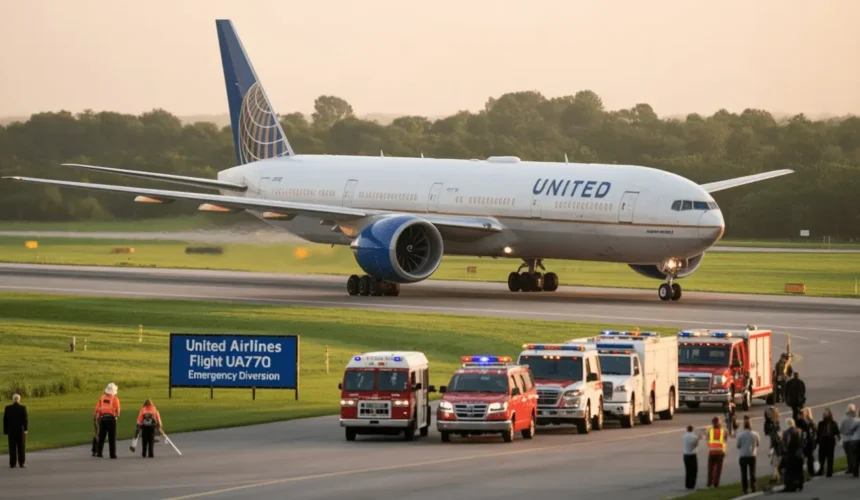Air travel is considered one of the safest ways to journey across long distances. However, on rare occasions, unexpected technical issues can arise that require immediate attention. One such event that drew international attention was the United Airlines flight UA770 emergency diversion. What began as a routine transatlantic journey suddenly shifted into an urgent situation, testing both the crew and the airline’s emergency procedures. While the incident ended safely, it provided valuable lessons on how modern aviation handles emergencies.
What was the incident?
United Airlines flight UA770 was scheduled to travel from Barcelona to Chicago, a route that typically spans several hours over the Atlantic Ocean. The flight was operating under normal conditions when a warning appeared in the cockpit indicating a potential issue with the aircraft’s cabin pressurization system. While the warning did not suggest immediate danger, it was serious enough that the pilots had to take precautionary steps to ensure passenger safety.
Following standard aviation practice, the pilots declared an emergency, signaling air traffic controllers with the universal “squawk 7700” code. This code alerts every relevant authority that the aircraft requires immediate priority and possible assistance. Within moments, the aircraft was rerouted and directed to the nearest major international airport capable of handling emergencies, which in this case was London Heathrow.
Timeline of events
To better understand the United Airlines flight UA770 emergency diversion, here is an overview of how the incident unfolded:
- The aircraft departed Barcelona on time and began its scheduled journey to Chicago.
- While cruising at high altitude, sensors indicated a possible malfunction in the pressurization system.
- The crew assessed the situation and, prioritizing safety, declared an emergency with air traffic control.
- The plane was quickly cleared for diversion to Heathrow Airport, one of the most well-equipped hubs for emergency landings.
- After a controlled descent and approach, the aircraft landed safely without any reported injuries.
This clear sequence of events illustrates how quickly airline crews and aviation authorities respond when signs of trouble arise.
Crew professionalism and passenger experience
A major reason why the United Airlines flight UA770 emergency diversion ended smoothly was the professionalism of the crew. Flight attendants and pilots are trained for a wide range of emergency scenarios, and this training was evident during the incident. The pilots acted decisively, maintaining constant communication with air traffic control, while the cabin crew kept passengers calm and reassured.
Passengers later described the atmosphere as tense but controlled. Announcements were made frequently to explain the diversion, and passengers were reminded that safety was the highest priority. This kind of transparency is crucial in maintaining confidence during unexpected situations. Although some travelers experienced delays and missed connections, many expressed gratitude for how the airline handled the circumstances.
Why diversions like this happen
Some travelers may wonder why a diversion was necessary if the pressurization system issue had not escalated into a full emergency. The answer lies in aviation’s strict adherence to safety protocols. Even minor system warnings are taken seriously because conditions at cruising altitude can deteriorate quickly if problems go unresolved. Cabin pressurization ensures that passengers and crew can breathe comfortably while flying at high altitudes. If it fails, oxygen levels drop rapidly, creating a potentially life-threatening scenario.
By diverting to Heathrow, the crew ensured that if the problem worsened, they would already be near an airport with medical staff, maintenance teams, and emergency services on standby. This decision reflects the principle that in aviation, prevention is always better than reaction.
Safety systems and protocols in action
The smooth outcome of the United Airlines flight UA770 emergency diversion highlights several layers of safety built into modern aviation.
- Early detection systems: Aircraft are equipped with advanced sensors that detect irregularities long before they become dangerous.
- Backup mechanisms: Most systems, including pressurization, are supported by redundancies that give crews time to respond effectively.
- Emergency codes: Declaring “squawk 7700” ensures instant recognition of a serious situation and prioritizes the flight among all other air traffic.
- Training and readiness: Pilots and flight attendants undergo rigorous emergency training so they can act with precision and calm when needed.
- Airport infrastructure: Major airports like Heathrow are equipped with emergency response facilities that can quickly handle such diversions.
Aftermath and operational response
Once the aircraft landed safely, the next steps included a full technical inspection to identify the root cause of the pressurization warning. United Airlines also worked to rebook passengers, arrange accommodations when necessary, and provide support for disrupted travel plans. Although inconvenient, these steps reflect the airline’s responsibility to minimize passenger stress after such an incident.
Operationally, events like this are also used as learning opportunities. Airlines and regulators typically review the incident to assess how systems performed and whether any improvements in maintenance or procedures are needed. While no airline wants an emergency diversion, each case contributes to strengthening industry-wide safety standards.
Lessons for travelers and the aviation industry
The United Airlines flight UA770 emergency diversion offers several important lessons:
- Passenger safety always comes first. A diversion may disrupt schedules, but it prevents much greater risks.
- Preparedness reduces panic. When passengers are kept informed with honest, calm communication, fear is replaced by trust.
- Modern aviation works in layers. From onboard technology to ground support, multiple safeguards combine to protect travelers.
- Rare events reinforce progress. Even though diversions are uncommon, they push the industry to continuously refine safety systems.
For passengers, the incident is a reminder that air travel remains remarkably safe, even when unexpected technical issues arise.
Conclusion
The United Airlines flight UA770 emergency diversion stands as a powerful example of how aviation safety systems are designed to protect passengers at every stage of a flight. From the moment the pressurization warning appeared to the safe landing at Heathrow, every step reflected careful training, strong decision-making, and a commitment to safety above convenience.
While travelers understandably hope never to experience an emergency diversion, the handling of UA770 should inspire confidence. It demonstrates that airlines, airports, and flight crews are prepared to manage emergencies quickly and effectively. In the end, the incident proved less about fear and more about the reassurance that aviation safety continues to work exactly as it should.







